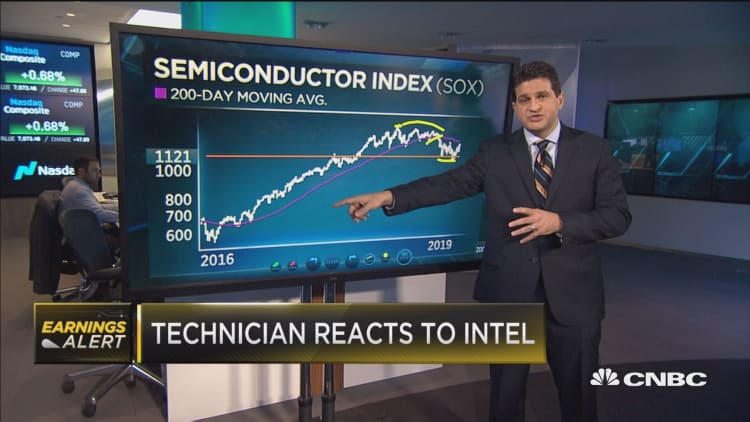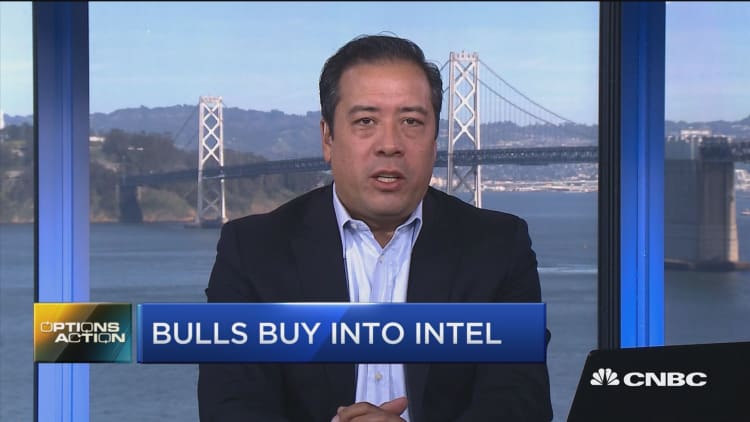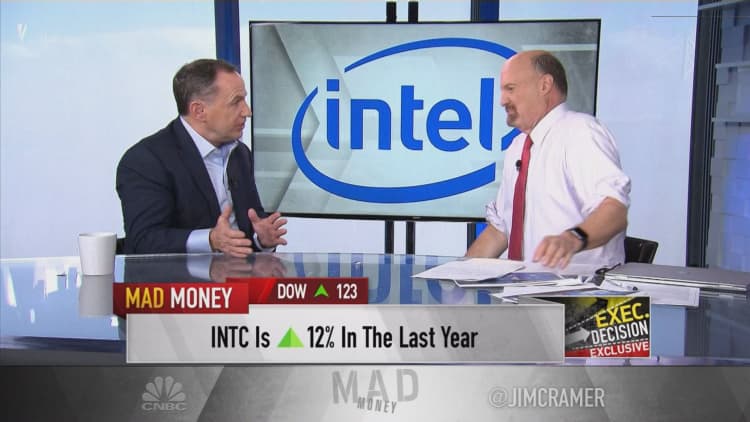Shares of Intel stock fell as much as 8 percent on Thursday after the company reported lower-than-expected revenue for the fiscal fourth quarter and light guidance.
Here's how the company did:
- Earnings: $1.28 per share, excluding certain items, vs. $1.22 per share expected by analysts, according to Refinitiv.
- Revenue: $18.66 billion, vs. $19.01 billion as expected by analysts, according to Refinitiv.
The company said in a statement that revenue went up 9 percent year over year in the quarter, which ended Dec. 29.
While the quarterly numbers are always important, investors are also eagerly awaiting an update on Intel's search for a new CEO. It's been seven months since Brian Krzanich was forced out after the company determined he'd been engaged in a "consensual relationship with an Intel employee." Bob Swan, Intel's finance chief, has since been serving as interim CEO.

"The board continues to evaluate candidates for what I believe is the biggest and best open job on the planet," Swan told analysts on a conference call following the earnings release on Thursday. "They are proceeding with a sense of urgency while also ensuring that they make the right choice for this great company."
The business segment that generates the most revenue for Intel, the Client Computing Group that includes PC chips, hit $9.82 billion in revenue in the fourth quarter, up 10 percent but below the $10.01 billion consensus estimate among analysts polled by FactSet.
"Supply remained constrained particularly at the value end of our product range," Swan said on the call. "We are working closely with our customers to align demand with available supply while we add capacity and we expect supply-demand balance to improve by mid-year."
Intel's Data Center Group, which includes chips for cloud providers, did $6.07 billion in revenue, below the $6.35 billion FactSet analyst estimate, while Non-Volatile Memory Solutions Group revenue totaled $1.11 billion, just under the $1.12 billion estimate.
Within the Data Center Group, growth from cloud fell sequentially from 50 percent to 24 percent as unit growth and average selling price growth both went down. Cloud providers are currently "absorbing capacity," Intel said in its quarterly presentation to investors.
With respect to guidance, Intel said it expects to post 87 cents in earnings per share, excluding certain items, on around $16 billion in revenue in the first quarter of 2019. Analysts had been looking for $1.01 per share, excluding certain items, on $17.35 billion in revenue, according to Refinitiv.
And for the full fiscal year, Intel predicted $4.60 in earnings per share, excluding certain items, on about $71.5 billion in revenue. That would imply revenue growth below 1 percent. The Refinitiv consensus was earnings of $4.54 per share, excluding certain items, and revenue of $73.19 billion.
Intel shares have gained 6 percent since the beginning of 2019. Over the past year, the stock is up almost 10 percent, while the S&P 500 is down more than 7 percent.
Heading into Thursday's report analyst sentiment is mixed, with some pointing to challenges like competition from AMD. Weston Twigg, an analyst at KeyBanc Capital Markets, said in a note to clients on Tuesday that he sees increasing risk of disappointing first-quarter guidance. Uncertainty surrounding demand from Apple is among the concerns.

"With the semiconductor industry facing a number of headwinds, a including a slowing Chinese economy, soft smartphone sales, softening auto demand, slowing hyperscale demand, a lingering government shutdown, and ongoing trade war certainty, Intel has remained in a strong position relative to peers, with its own supply shortages likely insulating it from headwinds," Twigg wrote. "However, we expect headwinds to mount in 1Q as data center demand likely continues to slow and Intel's new Apple modem business likely declines amid soft demand."
Swan said on the call that while revenue from modems were considerably below Intel's expectations because of lower smartphone demand.
And in Thursday's earnings presentation, Intel acknowledged that concerns about trade and macroeconomic environment have been "intensifying, especially in China."
In the fourth quarter, Intel said that in 2019 it would begin construction on expansions of manufacturing facilities in the U.S. and abroad, and that it had reached a diversity goal for U.S. employees two years ahead of schedule. It also announced a new wave of processors for desktop computers.
Intel said it expects around $15.5 billion in capital expenditures in the 2019 fiscal year. That's higher than the $14.26 billion FactSet estimate.
WATCH: Intel has its biggest addressable market ever: Interim CEO



